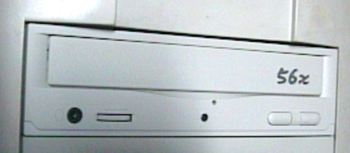Afreey 56X CD ROM Drive
Introduction
Reliability and speed are the primary criterions we look for when hunting for a new CD-ROM drive. Over the past Sony, Asus, Kenwood have proved themselves to be one of the best produces of optical devices. A common feature all these CD-ROMs feature is the X rating going up almost on a continuous basis, and the price seems to drop down in a similar fashion. Today a considerably good CD-ROM drive could be obtained for around $40, which is as cheap as some of your desktop speakers. So the question remains, do we require all this speed? Most definitely. If your requirements for a CD-ROM is merely to watch movies, a slower CD-ROM would do, but I’m sure you won’t find one in the market today, since they’re so obsolete. However most games that come today require a certain degree of CD-ROM support in gameplay. So the faster it is, slower lag you’ll notice.
Some of you might consider opting for a newer DVD drive and receive the benefits of both worlds, nevertheless what you must keep in mind is that a DVD drive costs significantly more than any DVD drive currently in the market. Besides no DVD drive today is capable of going beyond the 32X CD read speed. Currently the world record holder in CD-ROM drive speed is Kenwood’s 72 TrueX drive. They claim that this speed is equivalent to a 100X conventional CD-ROM drive. I have had my share of experience with one of these drives, and believe me they are fast. Ultra high speeds cannot be justified if the drive cannot support all formats of CD ROMS. The Kenwood drives cannot read most CD-RW’s, and even a lightly scratched ROM might not get recognized in this drive. Right now, the Kenwood drives aren’t the best thing to go for in my opinion, and the considerably higher cost further adds to this fact.
What we have in offer to you today is a drive we believe is a really great alternative to the Kenwood drive; the 56X CD-ROM drive from Afreey Inc. Best of all even at this high speed, the drive is capable of reading all CD-ROM formats, and it costs only $37. Now that’s value for money folks. In fact the tiny desktop speakers I use are more expensive than this. Lovely ain’t it.
Features
- Data Transfer Rate – CD:5600KB
- ATAPI/E-IDE Interface
- Support ULTRA DMA 33 & PIO MODE 4
- Support Windows 95/98/2000/NT/ME
- Compatible with All CD Formats
- High Speed Audio Extraction
- Vertical Mount Function
- Plug & Play Ready
- Multi-Read Function
- Complies with MPC3
- Low Vibration & Low Noise
- Emergency Manual Eject
| Interface Type |
ATAPI/E-IDE(Support DMA MODE 2, ULTRA DMA 33 ¤Î PIO MODE 4) |
| Interface Type Drive Performance |
Data Transfer Rate CD: 2145 – 4800 KB/SEC Access Time CD : 90 MS Driver Reliability (MTBF) 50,000POH (25% Duty Cycle at Room Temperature) |
| Disc Formats |
CD – ROM (MODE 1&2) CD – ROM/XA (MODE 2 ,FROM 1&2) CD – R , CD-RW , CD – EXTRA (CD+) PHOTO – CD (SINGLE & MULTI-SESSIONS) VIDEO CD V.11/2.0 , KARAOKE CDCD-I/MPEG , CD – WO , I – TRAX CD |
| OS Compatibility |
Windows ME/2000/NT/98/95, OS/2 WARP |
| User Friendly Front Panel |
Audio Play/Skip Button, Load / Eject ButtonEmergency manual eject, Stereo headphone jack/ Power on / Busy LED indicator/ Rotary volume control knob |
| Multi-Mount System |
Vertical and Horizontal |
| Dimensions |
149MM(W)X42MM(H)X196.5(D) |
| Weight |
1.05 KG(2.3lbs) |
Installation
Opening up the package you’re greeted with the drive, one IDE cable, audio cable for analog sound and a few screws. Installation of the drive was a breeze. Simply locate a free 5.25″ drive bay and secure the drive in with the supplied screws. Thereafter fix the IDE cable and the Audio cable to their respective devices. When Windows loaded it automatically detected the drive and loaded the appropriate drivers. Afreey supplies a diskette as for Windows 3.1 users, in case it doesn’t get recognized.

As for a software bundle, Afreey does not include anything as with their DVD drives.
Reading Mechanisms
There are three main mechanisms modern CD-ROM drives use when reading CD-ROMs. CLV (Constant Linear Velocity), CAV (Constant Angular Velocity) and P-CAV (Partial Constant Angular Velocity) are these three mechanisms. Here’s a brief insight to them.
CLV
This is a drive reading mechanism, which is used by almost every CD ROM drive. The disc spins faster when playing the inner side of the CD and slows when at the Outer surface.
CAV
High-speed drives cause a great degree of vibration as well as noise. Even today most creative CD-ROM drives have this problem. As soon as the drive starts it sounds like some kind of a monster and the drive vibrates so much you fear that it might even damage the CD. Anyway what manufactures do today to overcome this issue is, they implement the CAV technique. What it does is it keeps the drive rotating at a constant speed and with the help of a buffer, it compensates for the lost speed.
P-CAV
Most new drives include this mechanism as well. P-CAV is a combination of CLV and CAV. The drive utilizes the CAV mechanism when reading the inner tracks and uses CLV on the outer tracks. This not only increases the drive’s performance, reliability is also increased extensively.